Year 1921
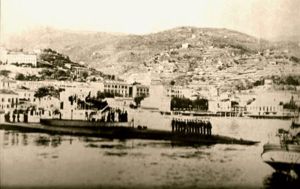 In 1921 a squadron of submarines came to visit Sanremo and Queen Helena also went to visit them.
In 1921 a squadron of submarines came to visit Sanremo and Queen Helena also went to visit them.
(The image is taken from a poster of the National Sailors' Association of Italy and the photo from which it is taken is from the Gino Guglielmi collection. It is dated 1920 but it could be one of the Submarines visiting Sanremo in 1921).
In the same year, a Naval Squadron made up of three Battleships appeared in our roadstead: Giulio Cesare, Andrea Doria and Caio Duilio with the escort of five destroyers.
The Squadron was commanded by Admiral Nicastro, who had already visited Sanremo eleven years before and had promised to return with another Squadron. And so he did!
The Battleship Andrea Doria (Class Caio Duilio), was the first of the Naval Squadron to arrive in the roadstead.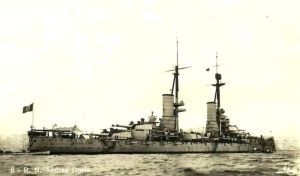
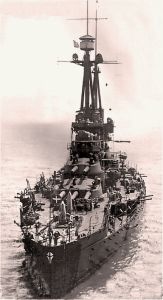 Set in 1912, launched in 1913, it was completed and entered service in 1916, then completely rebuilt in 1940.
Set in 1912, launched in 1913, it was completed and entered service in 1916, then completely rebuilt in 1940.
Built on a project elaborated by General Valsecchi, derived from the Conte di Cavour Class, it was built in the Arsenal of La Spezia.
In 1920 it was sent on a military political mission in Albanian and Dalmatian waters on the occasion of the occupation of Rijeka by GabrieleD'Annunzio.
In 1923 it took part in the occupation of Corfu follow-up of friction between Italy and Greece for the massacres of Janina.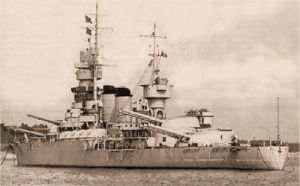 From 1937 to 1940 it underwent radical transformation works. Extended by 11 metres, new motorization was mounted and the towers for the new pieces were rebuilt. After the transformation works carried out in the Cantieri Riuniti dell'Adriatico in Trieste, she returned to the Squadron in October 1940.
From 1937 to 1940 it underwent radical transformation works. Extended by 11 metres, new motorization was mounted and the towers for the new pieces were rebuilt. After the transformation works carried out in the Cantieri Riuniti dell'Adriatico in Trieste, she returned to the Squadron in October 1940.
He took part in numerous war operations including the "First Battle of the Sirte" in 1941 and the escort of convoys to North Africa.
During the last 18 months of the war he remained inactive due to lack of fuel. After the Armistice of 8th September 1943 she went to Malta and was interned by the Allies.
With the Peace Treaty of 1947 she returned to Italy and became Headquarters of the Squadron until she was disarmed and disbanded in 1956.
It was demolished between 1957 and 1961.
(Technical Characteristics: Displacement: originally 25,200 tonnes fully loaded, reconstructed 29,200 tonnes p. c.; Speed: originally 21.50 knots, reconstructed 27 knots; Autonomy: originally 4800 miles at 10 knots, reconstructed 3390 miles at 20 knots.; Protection: originally 250 mm. belt, 97 mm. bridge, 280 mm. towers, 280 mm. tower. Rebuilt belt 250 mm., bridge 140 mm., towers 280 mm., tower 260 mm.; Armament: originally 13 pcs. 305/46 mm, 16 pcs. 152/45 mm, 13 pcs. 76/45 mm, 6 pcs. 76/40 mm, 2 pcs. 40/39 mm, 6 machine guns, 2 torpedo tubes 450 mm.; After rebuilt: 6 pieces Trinati in 2 towers of 320/44 mm., 4 pieces Binati in 2 towers of 320/44 mm., 12 p. Trinati in 4 towers of 135/45 mm.,10 p. single pieces of 90/50 mm.,19 single pieces of 37/54 mm., 12 single pieces of 20/65.; Crew: originally 1005 permanent effective, rebuilt 1495 permanent effective).
The Battleship Caio Duilio, twin ship of Andrea Doria, was built in the Shipyards of Castellammare di Stabia to be launched in 1913 and entered into service in 1915.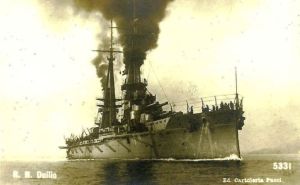 Disbarred and disarmed in 1956, it was demolished in 1957/ 1961.
Disbarred and disarmed in 1956, it was demolished in 1957/ 1961. 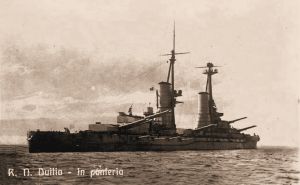 Designed and built like its Twin, from 1937 to 1940 it too underwent radical structural and armament transformation works at the Genoa Tyrrhenian Sea Shipyards.
Designed and built like its Twin, from 1937 to 1940 it too underwent radical structural and armament transformation works at the Genoa Tyrrhenian Sea Shipyards.
Extended by 11 metres, new motorization was mounted and the towers were rebuilt for the new pieces.
The works lasted until May 1941 and resumed service in Taranto in July of the same year.
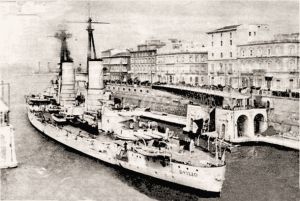 Not yet operational, it did not take part in the "Battle of Punta Stilo" on 9th July 1940.
Not yet operational, it did not take part in the "Battle of Punta Stilo" on 9th July 1940.
It was the object of the torpedo launch in the "the Battle of Taranto" between 11 and 12 November 1940, also known as "the Night of Taranto".
It underwent an 11 X 7 metres breach near the ammunition depot at Prua and was stranded in shallow water to prevent it from sinking.
It participated between November 1940 and January 1941 in the anti-aircraft defence of the stronghold.
In January 1941 it was afloat again and on 3rd February it entered the Basin in Genoa. The works lasted until May 1941 and resumed service in Taranto in July 1941.
After the Armistice of 8th September 1943 she went to Malta and was interned by the Allies.
After the Peace Treaty she returned to Italy and from 1947 to 1949 became the headquarters of the Naval Command.
It was transferred to La Spezia in 1953 until September 1956 when it was disarmed and then demolished.
(Characteristics of the Ship: Andrea Doria Class. Displacement at the origin and after the reconstruction, speed at the origin and after the reconstruction, protection at the origin and after the reconstruction, armament at the origin and after the reconstruction the same of the Andrea Doria).
The Battleship Giulio Cesare was built at the Ansaldo Shipyards in Genoa to be launched in 1911 and completed in 1914.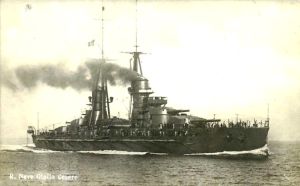 The doubts of its designer, General Masdea, about the efficiency of the superimposed towers were set aside and these were mounted for the first time on the Cavour Class ships.
The doubts of its designer, General Masdea, about the efficiency of the superimposed towers were set aside and these were mounted for the first time on the Cavour Class ships.
It was unusual, for the time, the view of twin towers mounted on trinate towers.
Having survived the First World War, the Conte di Cavour and Giulio Cesare were rebuilt in the 1930s.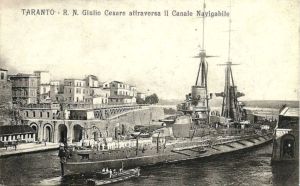 In 1923 it was used against the Island of Corfu' because of the Italian / Hellenic Crisis after the massacre of Italian Delegate Officers in Janina.
In 1923 it was used against the Island of Corfu' because of the Italian / Hellenic Crisis after the massacre of Italian Delegate Officers in Janina.
In 1933 it was transferred to the Genoa Tyrrhenian Sea Shipyards to be rebuilt at 60%, the equipment was updated, the displacement, the power of the engine and the speed increased.
In 1940 she took part in the "Battle of Punta Stilo" (she was hit by a grenade from the English Battleship Warspite) and the "Battle of Cape Teulada".
In 1941 she took part in the "First Battle of the Sirte".
On 11 September 1943 she sailed from Pula to Taranto and finally to Malta where she remained until the end of the Conflict.
In 1949 she was disbarred and ceded to the USSR and took the name Novorossiysk.
On the 30th October 1954 it sank in the port of Sevastopol officially because of a German mine but it seems that the cause was sabotage.
(Characteristics of the ship: displacement p.c. 25,086 tons. Speed: 21.50 knots. Armament: 13 pieces of 305 /46 mm.; 18 pieces of 120 /50 mm.; 16 pieces of 76/50 mm.; 6 pieces of 76/40 mm.; 3 tubes of 450 mm.).
The following two pictures are two postcards taken just in 1921, during the visit of you spoke above.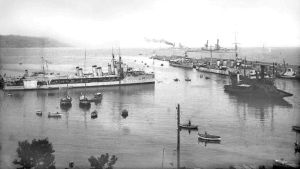 We would like to point out that the two Armored ships in the roadstead are the Andrea Doria and the Giulio Cesare
We would like to point out that the two Armored ships in the roadstead are the Andrea Doria and the Giulio Cesare
Moored at the east pier are the Destroyers La Masa (optical identification code on the LM side) and La Farina.
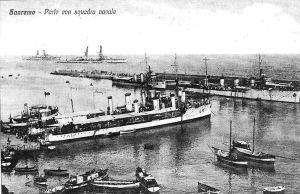
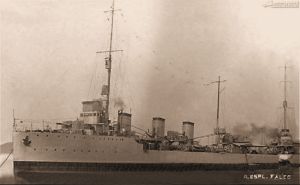 Moored at the long western pier are the Destroyers Premuda and Fabrizi and the Explorer Falco.
Moored at the long western pier are the Destroyers Premuda and Fabrizi and the Explorer Falco.
(Text and images from Coll.ne Dino Taulaigo)




